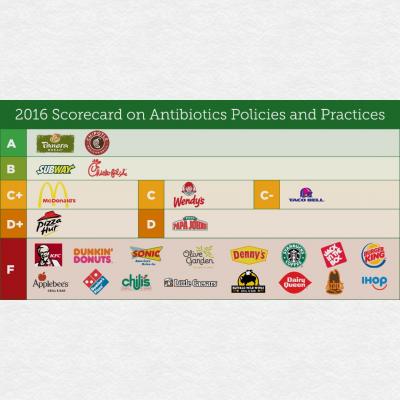The collaborative report, called Chain Reaction II, is the second annual report of its kind, giving a letter grade to each of the 25 chains based on their use of antibiotics. The report was coauthored by six nonprofit groups: Friends of the Earth, Natural Resources Defense Council, Consumers Union, Food Animal Concerns Trust, Keep Antibiotics Working, and the Center for Food Safety.
For the second year in a row, Chipotle Mexican Grill and Panera Bread were the only two chains included in the report to receive an A grade. Although sixteen of the top 25 chains have yet to make any progress in regards to serving meat raised without antibiotics, overall improvements were made from the previous year:
“The good news is that consumer and investor pressure has pushed twice as many companies as last year to create more responsible antibiotics policies, particularly for chicken. The bad news is that Olive Garden, KFC and 14 other chains received F grades and little progress has been made on pork and beef.”
Subway received a B grade this year, a massive leap from last year when they were among the F-graded restaurants. The jump is due to the fact that since last year’s report was released Subway has enacted previously nonexistent antibiotics policies concerning all types of meat they carry. The only other company to receive a B grade was Chick-fil-A.
Concerns with the use of antibiotics in animal agriculture are significant. Antibiotic resistance is a growing threat, and one that could have dire consequences. In the advancement of public health, antibiotics were a milestone. Unfortunately, they simply do not work the way that they used to, largely due to overuse. Seventy percent of important antibiotics for human medicine are used in animal agriculture, and the consumption of such meats only contributes to the issue of antibiotic resistance.
Additionally, the use of antibiotics in meat is often a signifier of poor living conditions for the animals. Typically, antibiotics are used on animals that aren’t even sick—and therefore do not really need them—in order to enhance growth and prevent illnesses that are likely to spread due to the crowded and dirty living conditions on factory farms.
While the report is a breath of fresh air in a food industry largely lacking transparency, it does not examine the whole story of how the meat was produced. Antibiotic use is an important consideration, but the sustainability and nutritional value of meat depends on other factors as well. Of course, the best way to be certain of the meat you are eating is to get to know a farmer or rancher and buy it locally!
What do you think? Do you try to avoid meat produced with antibiotics? Let us know!
For the second year in a row, Chipotle Mexican Grill and Panera Bread were the only two chains included in the report to receive an A grade. Although sixteen of the top 25 chains have yet to make any progress in regards to serving meat raised without antibiotics, overall improvements were made from the previous year:
“The good news is that consumer and investor pressure has pushed twice as many companies as last year to create more responsible antibiotics policies, particularly for chicken. The bad news is that Olive Garden, KFC and 14 other chains received F grades and little progress has been made on pork and beef.”
Subway received a B grade this year, a massive leap from last year when they were among the F-graded restaurants. The jump is due to the fact that since last year’s report was released Subway has enacted previously nonexistent antibiotics policies concerning all types of meat they carry. The only other company to receive a B grade was Chick-fil-A.
Concerns with the use of antibiotics in animal agriculture are significant. Antibiotic resistance is a growing threat, and one that could have dire consequences. In the advancement of public health, antibiotics were a milestone. Unfortunately, they simply do not work the way that they used to, largely due to overuse. Seventy percent of important antibiotics for human medicine are used in animal agriculture, and the consumption of such meats only contributes to the issue of antibiotic resistance.
Additionally, the use of antibiotics in meat is often a signifier of poor living conditions for the animals. Typically, antibiotics are used on animals that aren’t even sick—and therefore do not really need them—in order to enhance growth and prevent illnesses that are likely to spread due to the crowded and dirty living conditions on factory farms.
While the report is a breath of fresh air in a food industry largely lacking transparency, it does not examine the whole story of how the meat was produced. Antibiotic use is an important consideration, but the sustainability and nutritional value of meat depends on other factors as well. Of course, the best way to be certain of the meat you are eating is to get to know a farmer or rancher and buy it locally!
What do you think? Do you try to avoid meat produced with antibiotics? Let us know!






